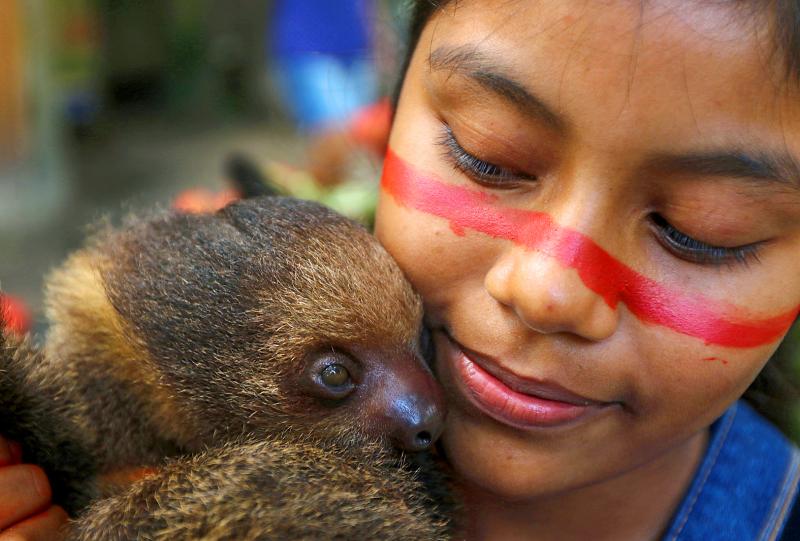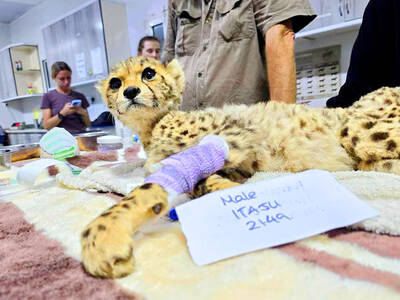Nobody seems to know quite how the sloth became the rock star of the animal kingdom. From high in the Latin American rainforest, the absurd mammal is the focus of a frenzied obsession that shows no sign of abating. Sloths are on bank notes, adverts, T-shirts, Internet memes and Instagram fan pages.
“People are obsessed,” said Costa Rican President Carlos Alvarado Quesada, when asked why people have fallen in love with the creature. “The sloth is quite a unique animal. It’s also very related to the forest. I believe it’s the elegance of the movement.”
Yet as with many examples of anthropomorphised wildlife, the trappings of fame have started to cause problems for the humble sloth.

Photo: AFP
They are among the most “selfied” animals on the planet, wildlife charity World Animal Protection said.
An analysis of Instagram images by the organization found that 70 percent of selfies with sloths — from the Brazilian Amazon to Central America — involve hugging, holding or using them as props.
The stress of constant handling and noise for a creature that spends most of the day asleep in the wild can have damaging consequences.
“If people are just seeing their images, but not really thinking of them as wild creatures, then it could do more harm than good because it’s feeding the frenzy,” said Sam Trull, who runs the Sloth Institute, an organization that rehabilitates the animals and reintroduces them into the wild in Manuel Antonio, Costa Rica.
The brown-throated three-toed sloths and Hoffmann’s two-toed sloths that hang from the rainforest in Manuel Antonio are a reassuring part of life in the national park area. The sight of a gray ball of fur clutching a cecropia tree lifts the darkest of moods.
Yet the urge to climb into the canopy and give the dozing mammal a cuddle has gone too far. Adoring tourists have become a threat.
“The photo-prop trade is a really big problem, where people take sloths out of the forest and charge money for people to hold them and take pictures with them. That’s the negative side of them being popular,” Trull said during a virtual tour of the sanctuary, where sloths are recovering from vehicle accidents, dog attacks and exhaustion from the heat of the dry season.
“Anything that increases their popularity in a shallow way could be dangerous,” Trull added.
In response to the problem, the Costa Rican government has launched the #stopanimalselfies campaign to crack down on the practice.
Although human and wildlife interaction has been illegal in the country for more than a decade, the 2017 World Animal Protection report said that Costa Rica ranked seventh in the world for “cruel” animal selfies.
“These interactions don’t just put wild animals at risk, they put tourists at risk too. Animals can transmit zoonotic illnesses through biting and scratching,” said Shirley Ramirez Carvajal, a wildlife biologist who works on the campaign.
The problem with wildlife selfies is not limited to sloths. Instagram has also been alert to the issue and has introduced warnings about the abuse of wild animals on popular hashtags such as #koalaselfie, #elephantride and #monkeyselfie, which are often filled with beaming images of tourists and wildlife.
“We have a law that bans direct contact with fauna and feeding wildlife. In this way, animals maintain wild behavior in the best possible way. Almost always, when animals get used to being fed or become comfortable around humans, there are accidents which can be quite serious,” Ramirez Carvajal said.
Alongside the eight-point code on ethical wildlife selfies, the Costa Rican government is encouraging tourists to report illegal behavior.
Once COVID-19 travel restrictions are lifted, thousands of tourists are expected once again to travel to Costa Rica, many of them hoping to catch sight of a sloth clinging to a tree in the rainforest.
It is an unlikely turnaround from the reaction of Spanish colonists, who dismissed them as ugly and useless.
“I think that they are a really good example of balance. Maybe this is one of the reasons why they are popular but this is also a reason why I think they should be popular with humans. A lot of people don’t have a lot of balance in their lives,” Trull said.
“Sloths are a really good example of how everyone should be living. I honestly think if more people were like sloths, we’d have world peace already,” Trull said. “They are excellent role models for all of us.”

ELECTION DISTRACTION? When attention shifted away from the fight against the militants to politics, losses and setbacks in the battlefield increased, an analyst said Recent clashes in Somalia’s semi-autonomous Jubaland region are alarming experts, exposing cracks in the country’s federal system and creating an opening for militant group al-Shabaab to gain ground. Following years of conflict, Somalia is a loose federation of five semi-autonomous member states — Puntland, Jubaland, Galmudug, Hirshabelle and South West — that maintain often fractious relations with the central government in the capital, Mogadishu. However, ahead of elections next year, Somalia has sought to assert control over its member states, which security analysts said has created gaps for al-Shabaab infiltration. Last week, two Somalian soldiers were killed in clashes between pro-government forces and

Ten cheetah cubs held in captivity since birth and destined for international wildlife trade markets have been rescued in Somaliland, a breakaway region of Somalia. They were all in stable condition despite all of them having been undernourished and limping due to being tied in captivity for months, said Laurie Marker, founder of the Cheetah Conservation Fund, which is caring for the cubs. One eight-month-old cub was unable to walk after been tied up for six months, while a five-month-old was “very malnourished [a bag of bones], with sores all over her body and full of botfly maggots which are under the

BRUSHED OFF: An ambassador to Australia previously said that Beijing does not see a reason to apologize for its naval exercises and military maneuvers in international areas China set off alarm bells in New Zealand when it dispatched powerful warships on unprecedented missions in the South Pacific without explanation, military documents showed. Beijing has spent years expanding its reach in the southern Pacific Ocean, courting island nations with new hospitals, freshly paved roads and generous offers of climate aid. However, these diplomatic efforts have increasingly been accompanied by more overt displays of military power. Three Chinese warships sailed the Tasman Sea between Australia and New Zealand in February, the first time such a task group had been sighted in those waters. “We have never seen vessels with this capability

‘NO INTEGRITY’: The chief judge expressed concern over how the sentence would be perceived given that military detention is believed to be easier than civilian prison A military court yesterday sentenced a New Zealand soldier to two years’ detention for attempting to spy for a foreign power. The soldier, whose name has been suppressed, admitted to attempted espionage, accessing a computer system for a dishonest purpose and knowingly possessing an objectionable publication. He was ordered into military detention at Burnham Military Camp near Christchurch and would be dismissed from the New Zealand Defence Force at the end of his sentence. His admission and its acceptance by the court marked the first spying conviction in New Zealand’s history. The soldier would be paid at half his previous rate until his dismissal